|


256-bit encryption
$500,000 protection

|
SS UNITED STATES
ocean liner model
If you are looking for a model of the tall ship USS
United States, click here:
USS United
States.
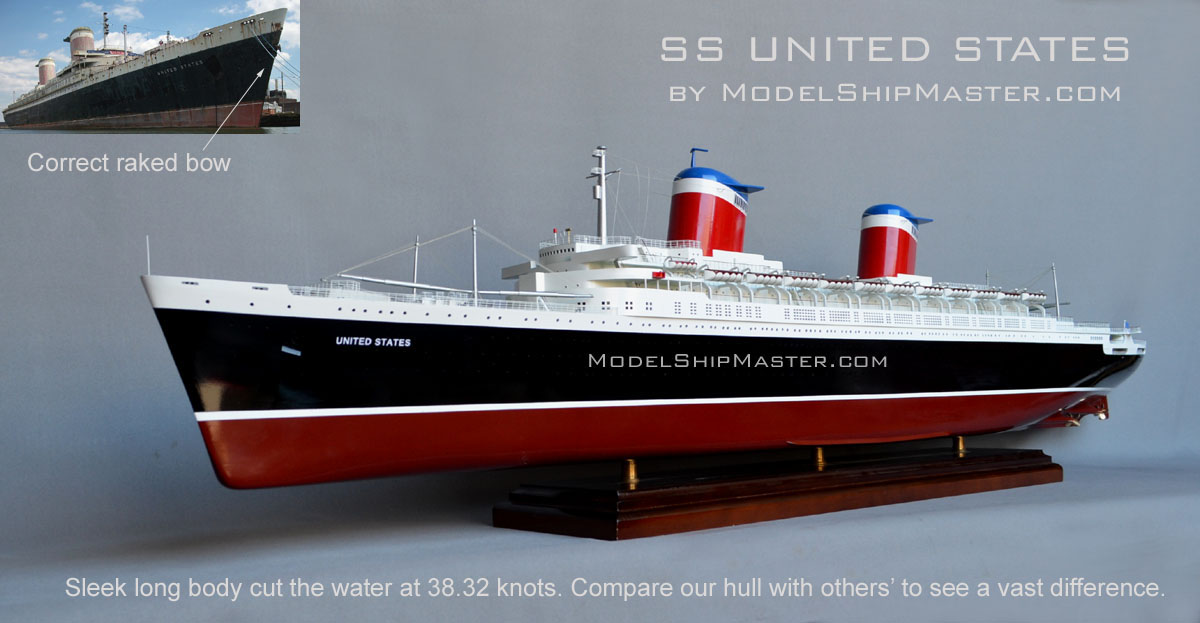
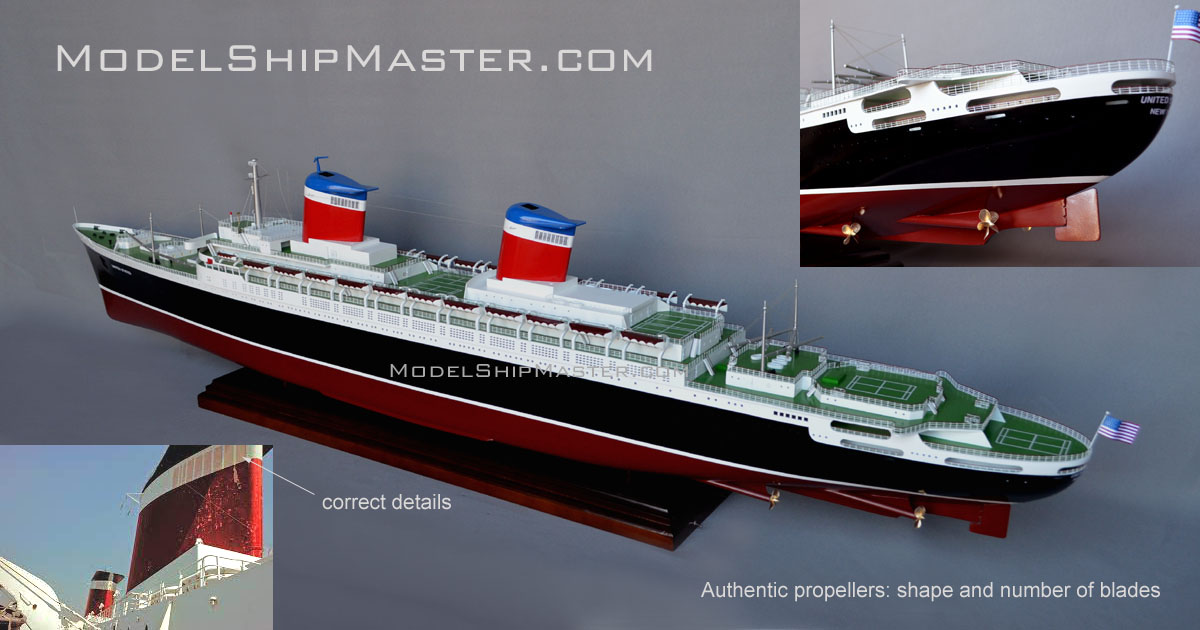
SS United States is one of the world's greatest
maritime achievements - a bold creation that
proclaimed American supremacy at sea. She smashed all
Atlantic speed records on her maiden voyage in 1952,
ripping the fabled Blue Riband prize from
the holder of 14 years
RMS Queen Mary.
Her crossing
was three days, ten hours and forty minutes which was
10 hours
shorter than
the Queen Mary's.
The liner's top
achieved speed was 38.32 kn (44 mph) -- stunning even
today when compared with 30 kn
by the modern Arleigh Burke-class destroyers and 20 kn
by the famous Paul Allen's
Octopus superyacht.
Her propulsion systems were a closely-guarded government secret.
The design of the propellers was overseen by the
pioneering Gibbs & Cox female engineer
Elaine Kaplan.
This super liner stretches to
990 feet. When she was built, she was
actually too big for the drydock in which she was
constructed and extended above and beyond of the
drydock doors. She is topped with two massive
tear-drop-shaped funnels that stand at 55 feet tall and
60 feet wide -- the largest ever put to sea. With spacious accommodations
for 2,000 passengers and 1,000 crew, each of her sailing was
like a city racing on water.
To achieve the aesthetic,
the SS United States was furnished with mid-century
modern decor that was amplified by plentiful use of
black linoleum decking and the silver lining of edges.
Because the ship served as a floating icon of the US, it
was decorated by theming spaces around an aspect of the
United States, such as the Mississippi River, Native
Americans, or American fauna. The liner was decorated
with hundreds of unique art pieces, including
sculptures, relief murals, and paintings. Aluminum was
commonly incorporated into the artworks, allowing pieces
to be light and fireproof, and to match the
black-and-silver theme. For instance, nearly 200
aluminum sculptures were used in the first-class
stairway, with a large eagle and each state's bird and
flower emblems on the landing of each deck.
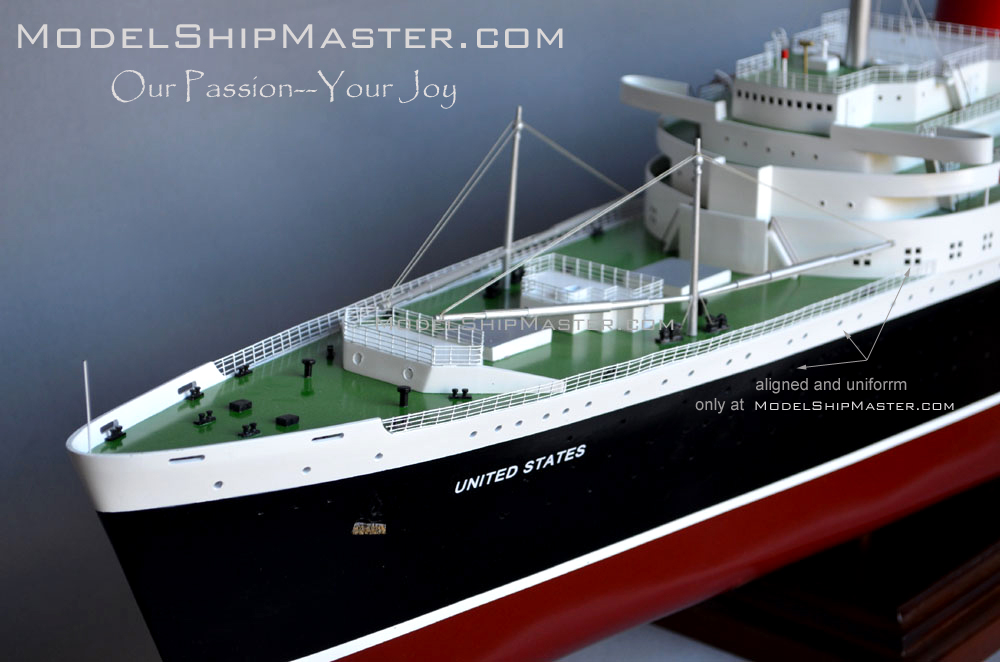
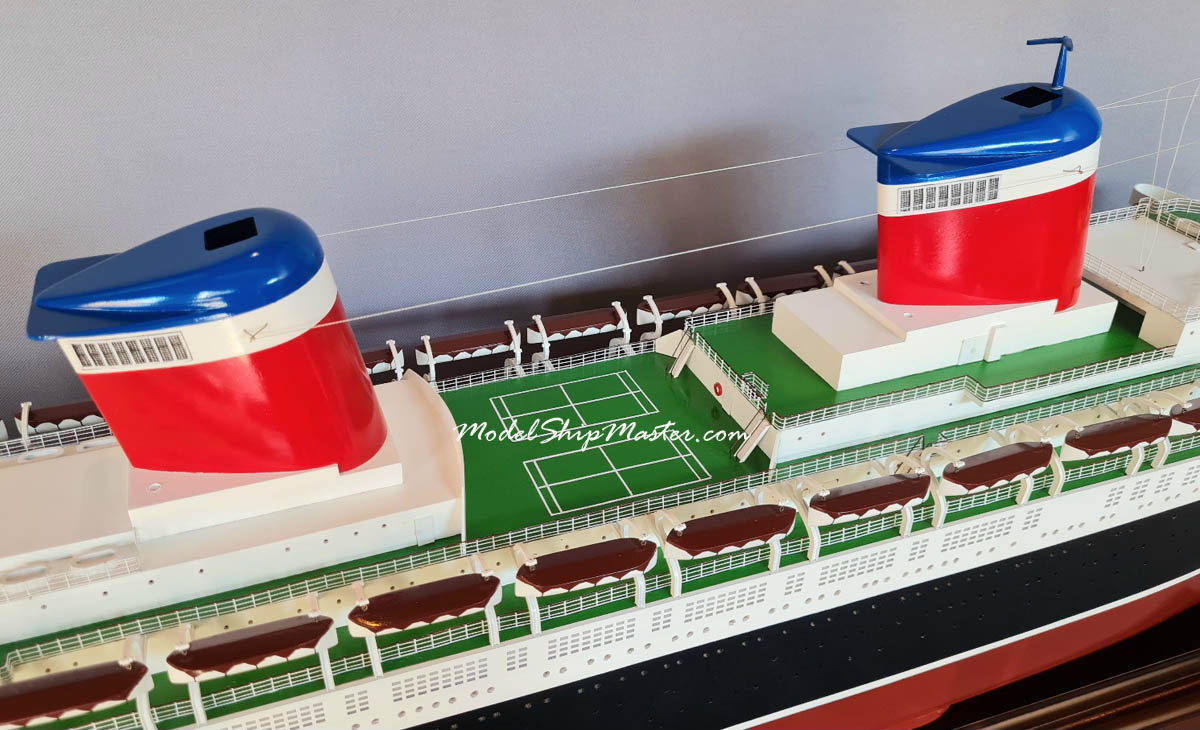
The
SS United States
was subsidized by the American government. Lessons
learned from the close of World War II when the U.S.
had to rely on British ships to ferry servicemen
home and the frosty early days of the Cold War
convinced the U.S. Navy of the need for a passenger
liner that could be converted quickly into a
troopship. But it wanted more. Naval requirements
for speed, safety, redundant engine rooms, etc. A
key safety feature was an elaborate labyrinthine of
wing tanks built into the double hull. If the ship
was punctured on one side, the tanks could be cross
flooded starboard to port or vice versus, allowing
the ship to remain on an even keel. The whole design
package came veiled in a tantalizing wrapper of
secrecy. The SS United States was the first
passenger liner to be built almost entirely in
drydock – far from prying eyes. The liner was
unveiled to the public already in the water,
ensuring its knife-like hull and propellers couldn’t
be studied by foreign enemies.
The ship’s designer,
self-taught naval architect William Francis Gibbs,
was so adamant that the SS United States be
fireproof that the only wood he allowed in its
outfitting were butcher blocks in the kitchen and
pianos – and even the latter was made of a special
flame-resistant mahogany, a quality which Theodore
Steinway proved by pouring gasoline over one and
tossing on a lit match.
While shipbuilders
began using aluminum more during WWII, its use was
limited because it can’t be welded. Gibbs was not
dissuaded. When steel and aluminum met, they didn’t
like each other, so Gibbs put a layer between the
two – neoprene. He not only built the SS United
States' entire superstructure from aluminum –
extremely unusual at the time, but also used the
metal everywhere possible. It was the largest amount
of aluminum used in any project in the world until
the Twin Towers were built in the early ‘70s. Gibbs
and his team figured out how to outsmart the
corrosive effect the two metals had on each other.
All combined, the hull design, compact
state-of-the-art engines, 250,000 HP boiler system
with its super-heated dry steam, the five-bladed
propellers, the super lightweight all-aluminum super
structure, the unheard of attention to numerous
safety measures – are just part of what created a
legend. “You can’t set her on fire, you can’t sink
her, and you can’t catch her,” Gibbs was known to
say.
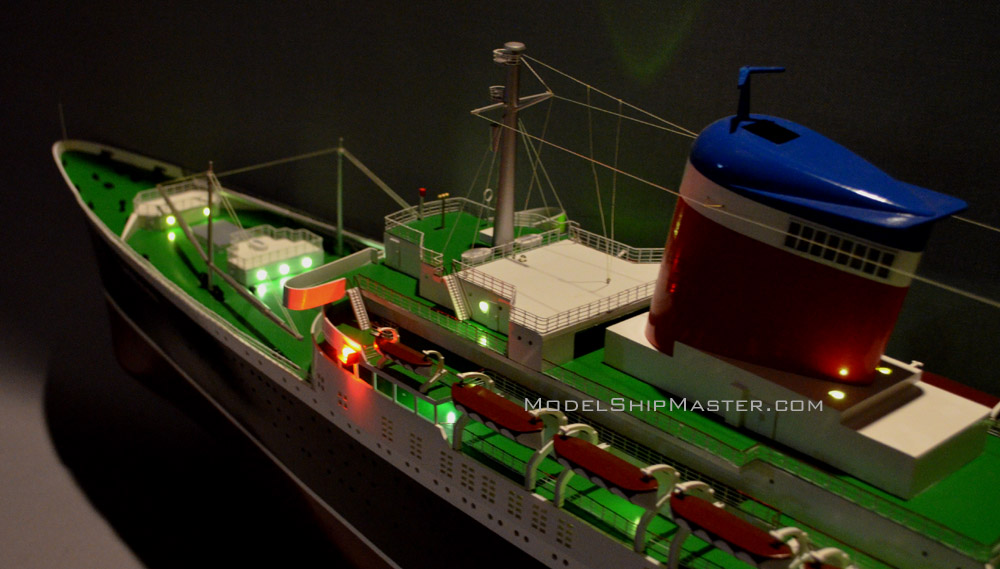
Although SS
United States remained the fastest vessel on the
North Atlantic, she could not compete with the speed
of jet planes. In 1969, she was laid up near her
birthplace in Hampton Roads, Virginia, for over 12
years. Then, she was purchased for use as a
cruise ship and changed hands several times. In
1996, she was towed back to the United States and remained in Philadelphia. In
2003, she was purchased by Norwegian Cruise Lines.
Although refitting her into a modern cruise ship
will probably cost more than building a new vessel,
she has an advantage a new-build cannot obtain: She
was built in the US, which means she can carry
passengers between American ports without calling
abroad.
Though no
longer in service, SS United States remains a proud
icon of American ingenuity and naval engineering. To
this day, her record-breaking crossings have yet to be broken.
“It was huge when an American ship took the record,”
says Arthur Taddei, who served as an engineering
officer on the United States. “That’s why people
were so passionate about it. It set a new standard.
It was like the
Constitution, which changed naval warfare. Of
course, when something comes out with huge red,
white and blue funnels, that makes it a very
dramatic symbol of this country.”
The SS United States’
staying power and structural integrity are a tribute
to the obsessive vision of its creator, William
Francis Gibbs – a Philadelphia native and Harvard
dropout whose life’s passion was to build the
world’s greatest ocean liner. Despite having no
formal training as a naval architect, his firm Gibbs
& Cox designed 70% of all navy vessels during World
War II. Gibbs’ affection for the ship was such that
every time the ship came into New York, he rushed
over in a chauffeured Cadillac to meet her. He
called the SS United States nearly every day she was
at sea, asking after turbine revolutions and fuel
consumption. When Gibbs died in 1967, the liner
sailed beneath his office in lower Manhattan and
sounded a funeral blast.
Today, the
ship's bell is kept in the clock tower on the campus of
Christopher Newport University. A four-bladed propeller
from the liner is on display at the entrance to Pier 76
in Manhattan. The propeller is 18 feet in diameter and
weighs over 30 tons. Another four-bladed propeller is on
display at the American Merchant Marine Museum. A
five-bladed propeller is with the Mariners' Museum. The
other five-bladed stays with the State University of New
York Maritime College. Their photos are located
here. A large collection of dining-room furniture
and other memorabilia from SS United States are at the
Mariners' Museum and Christopher Newport University.
This
page has photos of the interior.

This primarily wood SS United States model features:
-
Plank-on-frame hull
- Windows and portholes are cutouts (not black decals),
uniform, and on straight lines.
- Captivating
lighting, with and green/red navigation
light that will light up your special evenings.
A ship is not an ocean liner without beautiful
lighting.
LED light powered by standard 9v
battery for your convenience.
-
Click
here to learn more about authentic ocean liner
models.
- 34"
long
(1/350 scale) $3,775 Shipping and insurance in
the contiguous USA included.
Other places: $400 flat rate.
- 62" long
x 16" tall x 8" wide
(1/200 scale). Contact us for price. A
model of this size was delivered to a director of
the SS United States Conservancy in October 2024.
Model is built per commission only.
We require only a small deposit to start the
process. Please click
here for
more details.
- 47.5" long
(1/250 scale) See
progress photos below. $5,750
 Shipping and
insurance in the contiguous USA included. Other
places: $500 flat rate. One unit will be
available for sale in June 2025.
Shipping and
insurance in the contiguous USA included. Other
places: $500 flat rate. One unit will be
available for sale in June 2025.
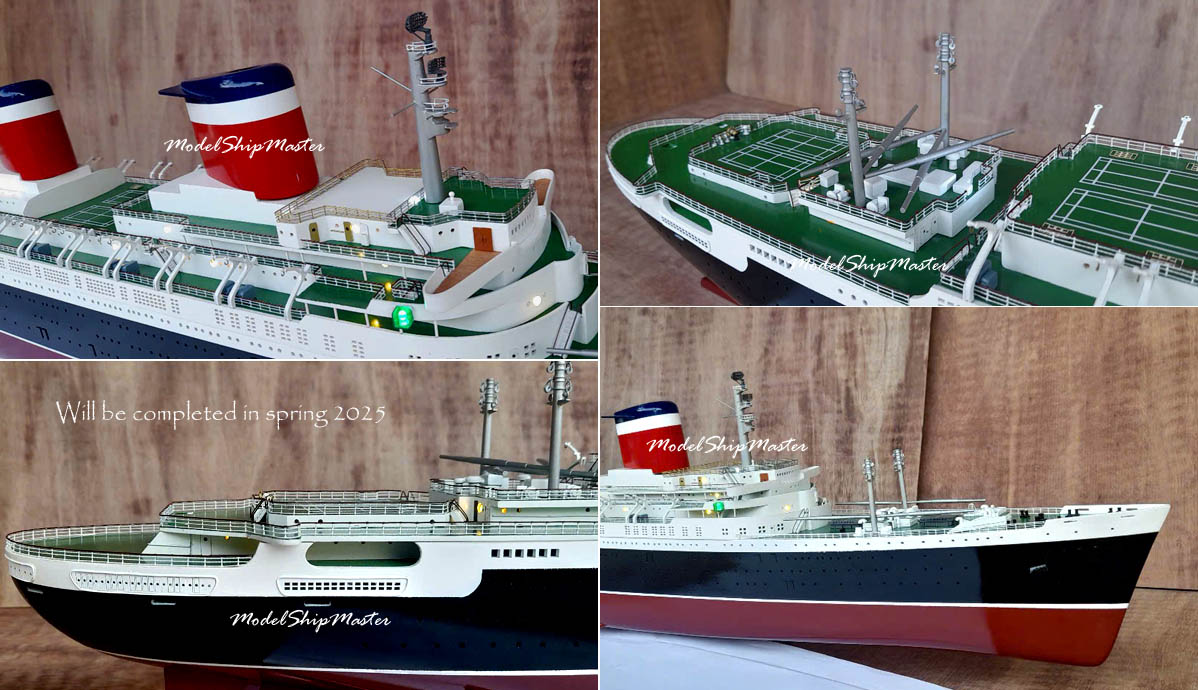
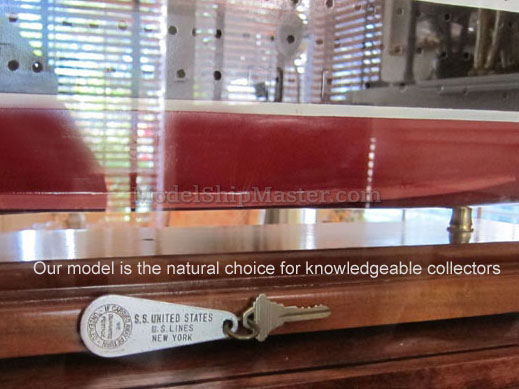 |
"Just wanted to say THANK
YOU!!! My SS United States model arrived today and it's absolutely
incredible, you guys do amazing work! I haven't
stopped staring at the model since it arrived!
Brian"
"As it turned out, I received an update that the
delivery date changed back to today and the model arrived at 10AM this morning. You
were kind enough to suggest the steps I should follow to
unpack it which worked out nicely. I very much
appreciated the most secure packaging. I was most
fortunate to serve as a substitute
Third Mate on the SS United
States for
four round trip voyages to Northern Europe from NYC
(voyages 393, 394, 395 and 396 from July 17, 1969 to
September 10, 1069 out of the four hundred voyages she
made before retiring).
Your precision and masterful work on the
model is truly superb and brings back some terrific
memories. Thank you. Regards, Harry" "Just to let you know SS United
States model and display case arrived safe and sound. Beautifully
packaged. I think it could have withstood a direct nuclear strike.
Interestingly, I flew over the real SS United States rusting in
Philadelphia same day I got home to put the model into its display case.
Such a pity to see such a great, beautiful ship deteriorate. I sailed
her 4 times and on her sister ship SS America twice. Best, Allan
Hamilton" |
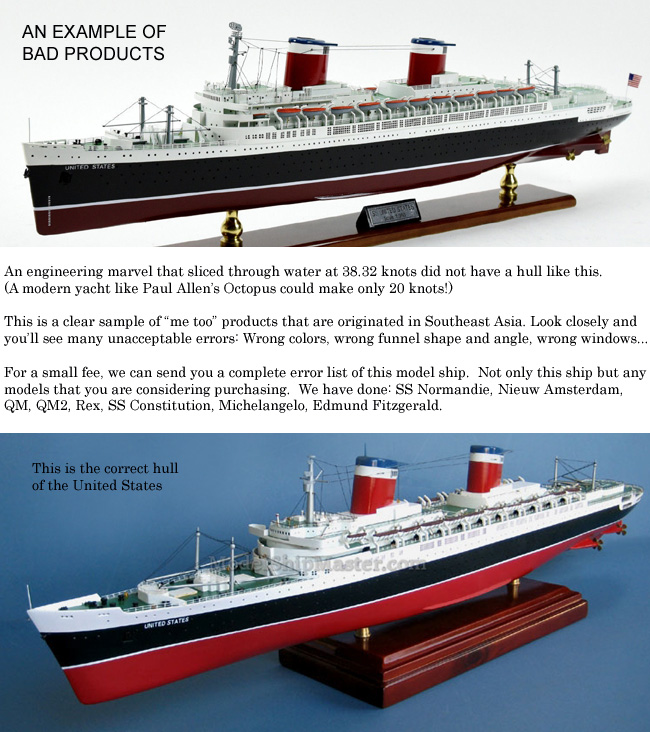
Click for our beautiful
SS Independence model, SS
Constitution model, and
SS America model
|